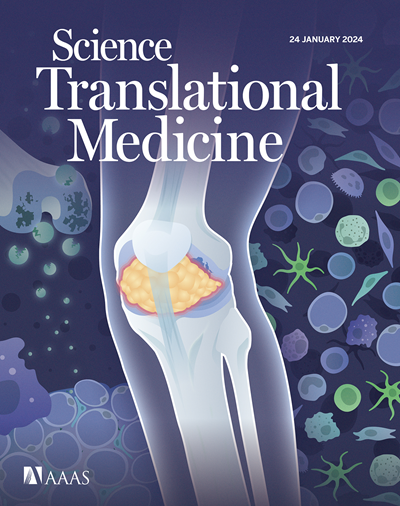调节性T细胞减轻肥厚性心肌病的慢性炎症和心脏纤维化
IF 14.6
1区 医学
Q1 CELL BIOLOGY
引用次数: 0
摘要
肥厚性心肌病(HCM)是一种常见的、严重的遗传性心肌疾病。尽管肌瘤蛋白的基因变异破坏心肌细胞功能的生物物理机制在很大程度上被理解,但导致非肌细胞室复杂、可变和不利重构的细胞和分子途径仍未得到解释。在这里,我们报告了死后和移植的人类HCM心脏表现出慢性局灶性白细胞浸润和免疫细胞的显著激活。基因集富集分析(GSEA)显示,在HCM中期和晚期人类心脏以及几种HCM小鼠模型的小鼠心脏中存在主动免疫反应。选择α心脏肌动蛋白1-E99K (Actc1 E99K) HCM小鼠模型进行研究,因为它紧密地概括了晚期疾病患者进行性重塑和纤维化的特征。重组激活基因1敲除(Rag-1 KO)小鼠中淋巴细胞的基因缺失导致Actc1 E99K小鼠不良心脏重构的显著加剧。心脏调节性T细胞(T reg细胞)的详细表征表明,Actc1 E99K心脏的时间依赖性增加,免疫抑制谱改变。脾T细胞过继性转移可减少有或无淋巴细胞的Actc1 E99K小鼠的心脏纤维化并改善收缩功能障碍。此外,在体内特异性诱导T细胞扩增的低剂量白介素-2 (IL-2)/抗IL-2复合物(IL-2/c)改善了Actc1 E99K小鼠的心脏纤维化,减少了巨噬细胞的浸润和活化。这些数据有助于我们对HCM的理解,并支持使用T细胞作为HCM心脏纤维化的临床可测试治疗策略。本文章由计算机程序翻译,如有差异,请以英文原文为准。
Regulatory T cells attenuate chronic inflammation and cardiac fibrosis in hypertrophic cardiomyopathy
Hypertrophic cardiomyopathy (HCM) is a common, serious, genetic heart muscle disorder. Although the biophysical mechanisms by which gene variants in sarcomeric proteins disrupt cardiomyocyte function are largely understood, the cellular and molecular pathways leading to the complex, variable, and adverse remodeling of the non-myocyte compartment are unexplained. Here, we report that postmortem and explanted human HCM hearts exhibited chronic focal leukocyte infiltration and prominent activation of immune cells. Gene set enrichment analysis (GSEA) revealed that active immune responses were present in the mid- and late-stage HCM human hearts and in mouse hearts from several HCM mouse models. The alpha cardiac actin 1-E99K (Actc1E99K) HCM mouse model was selected for the study because it closely recapitulates the features of progressive remodeling and fibrosis seen in advanced disease in patients. Genetic depletion of lymphocytes in recombination activating gene 1–knockout (Rag-1KO) mice led to marked exacerbation of adverse cardiac remodeling in the Actc1E99K mice. Detailed characterization of cardiac regulatory T cells (Treg cells) demonstrated a time-dependent increase in Actc1E99K hearts with altered immunosuppressive profiles. Adoptive transfer of splenic Treg cells reduced cardiac fibrosis and improved systolic dysfunction in Actc1E99K mice with or without lymphocytes. In addition, low-dose interleukin-2 (IL-2)/anti–IL-2 complex (IL-2/c), which specifically induced Treg cell expansion in vivo, ameliorated cardiac fibrosis and reduced macrophage infiltration and activation in Actc1E99K mice. These data contribute to our understanding of HCM and support the use of Treg cells as a clinically testable therapeutic strategy for cardiac fibrosis in the HCM heart.
求助全文
通过发布文献求助,成功后即可免费获取论文全文。
去求助
来源期刊

Science Translational Medicine
CELL BIOLOGY-MEDICINE, RESEARCH & EXPERIMENTAL
CiteScore
26.70
自引率
1.20%
发文量
309
审稿时长
1.7 months
期刊介绍:
Science Translational Medicine is an online journal that focuses on publishing research at the intersection of science, engineering, and medicine. The goal of the journal is to promote human health by providing a platform for researchers from various disciplines to communicate their latest advancements in biomedical, translational, and clinical research.
The journal aims to address the slow translation of scientific knowledge into effective treatments and health measures. It publishes articles that fill the knowledge gaps between preclinical research and medical applications, with a focus on accelerating the translation of knowledge into new ways of preventing, diagnosing, and treating human diseases.
The scope of Science Translational Medicine includes various areas such as cardiovascular disease, immunology/vaccines, metabolism/diabetes/obesity, neuroscience/neurology/psychiatry, cancer, infectious diseases, policy, behavior, bioengineering, chemical genomics/drug discovery, imaging, applied physical sciences, medical nanotechnology, drug delivery, biomarkers, gene therapy/regenerative medicine, toxicology and pharmacokinetics, data mining, cell culture, animal and human studies, medical informatics, and other interdisciplinary approaches to medicine.
The target audience of the journal includes researchers and management in academia, government, and the biotechnology and pharmaceutical industries. It is also relevant to physician scientists, regulators, policy makers, investors, business developers, and funding agencies.
 求助内容:
求助内容: 应助结果提醒方式:
应助结果提醒方式:


